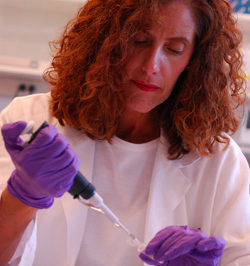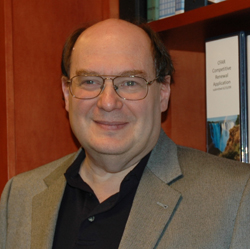Drs. Jonathan Karn and Janet Siliciano,
two distinguished researchers who have benefited from amfAR funding, recently
visited the Foundation’s offices to discuss their cure-focused work.
Two paths to a cure
Dr. Siliciano, of Johns Hopkins
University and a member of the amfAR Research Consortium on HIV Eradication
(ARCHE), is researching assays that can measure hidden reservoirs of HIV to
determine where, and in what amounts, the virus resides in the body.

Dr. Janet Siliciano“The reason why you can’t cure someone
of HIV is because HIV hides in the body in reservoirs,” says Dr. Siliciano.
“The best studied reservoir to date is that of resting memory cells. The drugs
don’t touch this reservoir and the immune system doesn’t see it. So HIV is
hiding in cells that are designed to live a long time in the body and we can’t,
at this point, do anything about it.”
“But if we experimentally figure out
ways to eradicate this reservoir,” she says, “we could potentially cure someone
of HIV infection. And now we have many of the tools to study this reservoir,
developed at our lab and other labs through funding from amfAR.”
Totally crazy
Dr. Karn, of Case Western Reserve
University, is tackling HIV from another angle, studying the ways in which
virus inserts itself into human DNA.
“If you understand the machinery of
cells, then you can find an opportunity to create a drug that does what you
want it to do,” says Dr. Karn. “In this case, we want to have a drug that can
reactivate latent viruses. If you’ll forgive the analogy from World War I, it’s
like getting somebody to stick their head out of the trench so you can get a
shot at them. The virus is lurking around in the trenches and we want to be
able to attack it. And attack it in very specific ways.”
“Ten years ago, this concept wasn’t the
least bit controversial. It was totally crazy! And I give amfAR a lot of credit
for understanding that it is important to think about a cure.”
Rediscovering old drugs
Dr. Siliciano and the ARCHE team are
testing drugs that have already been approved by the US Food and Drug
Administration (FDA) for other uses. It is possible, given the number of drug
compounds that have been discovered over the years, that one of them will also
be effective in fighting the spread of HIV.
“At Hopkins, we took advantage of a drug
library that was put together by a student in another lab,” says Dr. Siliciano.
“And out of this library came the drug disulfiram, which woke up HIV out of
latently infected, resting CD4 cells without globally activating T cells.”
Disulfiram, which is marketed as
Antabuse, is approved by the FDA to treat alcoholism. Because it is
FDA-approved, the ARCHE team was able to put it quickly into a clinical trial.
“It was exciting because within a very
short time we were able to take a drug that we had identified in a screening
and bring it into patients,” says Dr. Siliciano. “So instead of waiting 10 or
15 years, we did it in a year.” The study is ongoing.
Will we find a cure?
“Looking at the history of viral
epidemics, if they go untreated, you get evolutionary resistance,” says Dr.
Karn. “That’s why the AIDS-type viruses in monkeys don’t cause disease in their
natural hosts. To get to that point, you might lose 90 percent of your
population and have to wait for thousands of years. It’s not a good medical strategy.”

Dr. Jonathan Karn“But if you look at the history of AIDS
in humans, there has been phenomenal success over the last 30 years. Thirty
drugs in 30 years is completely unheard of. It’s gone from an immediate death
sentence to a serious but manageable chronic disease.”
“There have been new insights into how
cells and viruses work that set the stage for a whole new generation of
research. And if the field’s able to continue at the same rate, then I’ll stick
my neck out and say in 20 years there will be an effective vaccine, there will
be curative strategies, and the issue will be, ‘How do you deliver this to the
people who need it?’”
Dr. Siliciano also expects a cure to be
found in her lifetime. “We still have a long road ahead of us, but we have a
lot of bright, committed people,” she says. “And amfAR is right there funding
scientists to do the research—the best scientists who are now working. We’ve
all done our part towards curing HIV. And I think amfAR is going to go a long
way towards making that happen.”